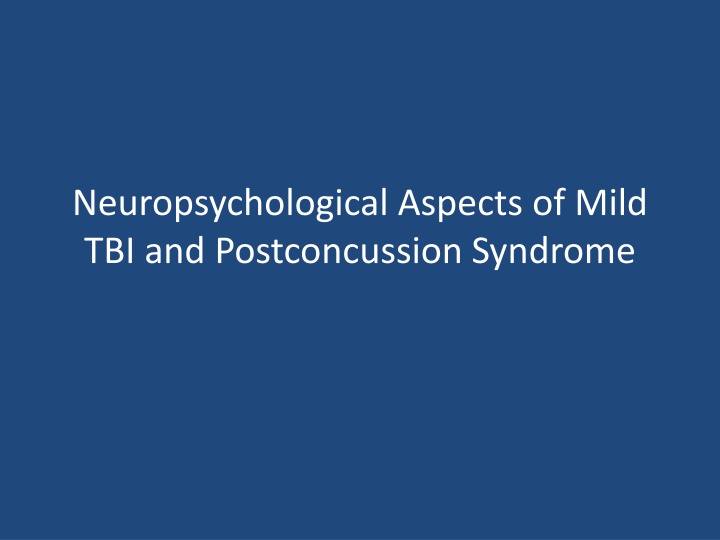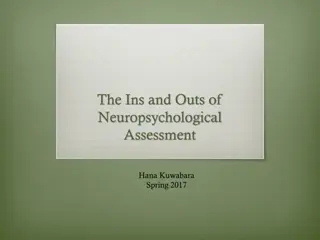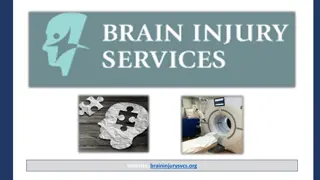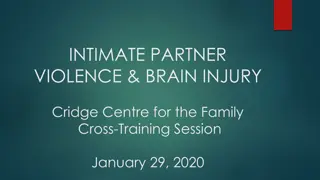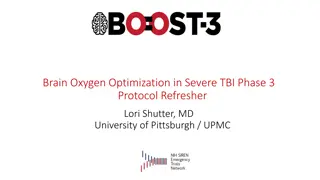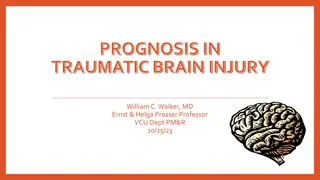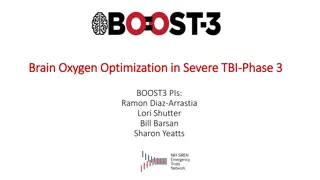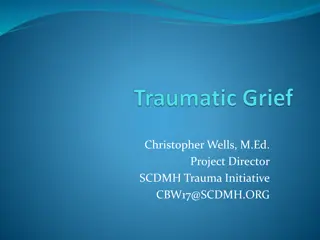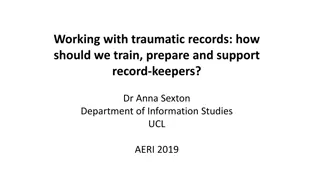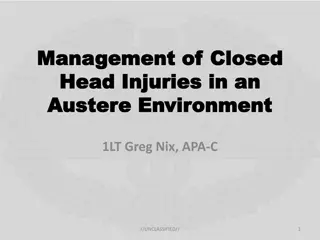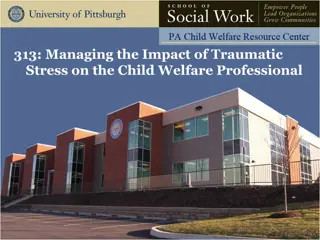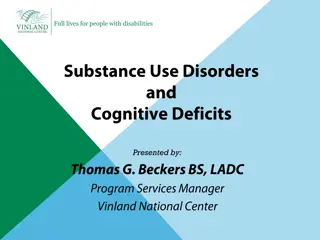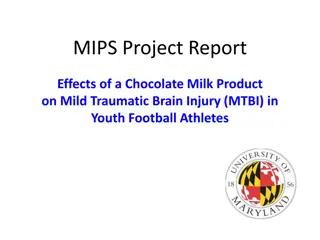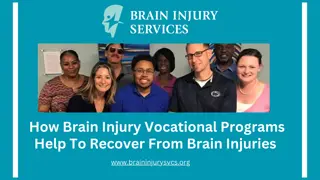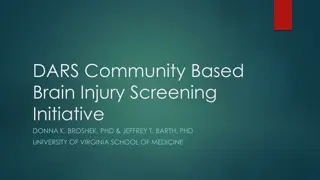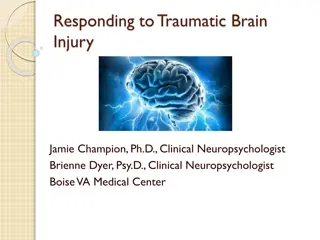Neuropsychological Aspects of Mild Traumatic Brain Injury
This presentation delves into the neuropsychological aspects of mild traumatic brain injury (TBI) and postconcussion syndrome, addressing long-term cognitive outcomes, specific diagnoses, symptom management, and more. Authored by experts in the field, it provides valuable insights into understanding and managing the complexities of TBI-related conditions.
Download Presentation

Please find below an Image/Link to download the presentation.
The content on the website is provided AS IS for your information and personal use only. It may not be sold, licensed, or shared on other websites without obtaining consent from the author.If you encounter any issues during the download, it is possible that the publisher has removed the file from their server.
You are allowed to download the files provided on this website for personal or commercial use, subject to the condition that they are used lawfully. All files are the property of their respective owners.
The content on the website is provided AS IS for your information and personal use only. It may not be sold, licensed, or shared on other websites without obtaining consent from the author.
E N D
Presentation Transcript
Neuropsychological Aspects of Mild TBI and Postconcussion Syndrome
Message to Presenters May 1, 2017 Our goal was to develop a 1.5 hour long presentation on postconcussion syndrome, and comprehensive coverage of every topic was impossible. The omissions include, but are not limited to, coverage of chronic traumatic encephalopathy, the assessment of performance and symptom validity, and more than a few details of the neuropsychological outcome studies. Notes are visible under some slides.
Authors & Disclosures Authored by Laurence Binder, Ph.D., ABPP-CN, Glenn Larrabee, Ph.D., ABPP-CN, and Michael Kirkwood, Ph.D., ABPP-CN Laurence Binder and Glenn Larrabee perform medicolegal evaluations and consult for disability insurers. Glenn Larrabee and Michael Kirkwood receive royalties on the sales of two books mentioned in the presentation
Acknowledgments Jacobus Donders, Ph.D. Stephen Macciocchi, Ph.D. Arthur Maerlander, Ph.D. Michael McCrea, Ph.D. AACN Publications Committee (Jerry Sweet, Ph.D., Chair)
Developed by Laurence Binder, Glenn Larrabee, and Michael Kirkwood. Dr. Binder initiated the project and had lead responsibility. Some of the content was adapted from a prior presentation by Dr. Larrabee. Drs. Larrabee and Kirkwood made significant contributions to the content and editing.
This presentation and its content was neither authored by AACN nor evaluated by AACN for accuracy. This presentation shall not be considered a position or policy statement issued by AACN. AACN makes no representations or warranties concerning the content, and is not liable or responsible for the material within.
Objectives: The participants will be able to 1. Explain why the term postconcussion syndrome often is not clinically useful. 2. Summarize long term cognitive outcome after concussion. 3. Discuss more specific neuropsychological and psychiatric diagnoses that can be applied more accurately to patients often diagnosed with postconcussion syndrome. 4. Discuss management of symptoms attributed to concussion.
Are prolonged symptoms after concussion pathophysiologic or psychogenic? Debate about causation dates from the 19th century advent of railroads and railroad accidents. John Eric Erichsen: Railway Spine (1866): symptoms w/o visible injury could be neurologic, resulting from molecular disturbance Herbert Page (1882) challenged Erichsen, pointing out the lack of evidence of molecular disturbance Trimble, MR. (1981) Post-traumatic Neurosis: From Railway Spine to the Whiplash, Wiley Medical
Definition Concussion and mTBI refer to the acute effects Alteration of level of consciousness defined by confusion, posttraumatic amnesia (PTA), repetitive questions, or loss of consciousness. Postconcussion syndrome Refers to nonspecific symptomatology that persists after mTBI. Not a true syndrome because the symptoms are nonspecific and do not usually occur together. No widely accepted pathology or diagnostic criteria
Concussion: American Congress of Rehabilitation Medicine 1993 A traumatically induced physiological disruption of brain function manifested by at least one of the following: Any loss of consciousness (LOC), any loss of memory for events immediately before of after the accident, any alteration in mental state at the time of the accident (feeling dazed, disoriented or confused), and focal neurologic deficits that may or may not be transient LOC 30 min, after 30 min Glasgow Coma Scale (GCS) is 13-15, and posttraumatic amnesia (PTA) is 24 hours (J Head Trauma Rehabil 1993, 8, 86-87)
Problems with ACRM definition Focal deficits that may be persistent may herald a more severe TBI Patient report of feeling dazed, disoriented or confused are non-specific No significant differences between other injury (no TBI) and mTBI groups in feeling dazed (52% vs. 71%), disoriented (42% vs. 33%) or confused (65% vs. 67%) (Lees-Haley et al., 2001, Archives Clinical Neuropsychology, 689-695)
World Health Organization Definition mTBI is an acute brain injury resulting from mechanical injury to the head from external physical forces resulting in: one or more of the following: confusion or disorientation, LOC for 30 min, PTA 24 hours, and/or other transient abnormalities such as focal signs, seizure, and intracranial lesion not requiring surgery GCS of 13-15 > 30 min post injury Above manifestations cannot be due to drugs, etoh, medications, or caused by other injuries (Kristman et al. 2014, Arch Phys Med & Rehab, 95 (3 Suppl 2), 265-770
Problem with WHO Criteria Allowing presence of intracranial lesion includes a category of mTBI referred to as complicated mTBI that sometimes has outcome more similar to that associated with moderate TBI, i.e. these persons may not make complete recovery
VA/DOD 2016 Criteria for TBI TBI is a traumatically induced structural injury and/or physiological disruption of brain function as a result of external force and is indicated by at least one of the following clinical signs immediately following the event: Any period of LOC or decreased level of consciousness Any loss of memory for events immediately before or after the injury (PTA) Any alteration in mental state at the time of injury (confusion, disorientation, slowed thinking) Neurological deficits (weakness, loss of balance, change in vision) which may or may not be transient Intracranial lesion https://www.healthquality.va.gov/guidelines/Rehab/mtbi/mTBICPGFullCPG50 821816.pdf
VA/DOD definition does not require direct external trauma to the head External forces include the brain undergoing acceleration/deceleration movement without external head trauma Blast injuries are included
Alteration of mental status VA/DOD Alteration of mental status must be immediately related to head trauma. Typical symptoms are looking and feeling dazed and uncertain of what is happening, confusion, difficulty thinking clearly or responding to mental status questions, and being unable to describe events immediately before or after the trauma.
VA/DOD Classification of TBI Severity (if criteria met in > 1 category of severity, assign the higher level of severity) Criteria Mild Moderate Severe Structural Imaging Normal Normal or Abnormal Normal or abnormal Loss of 0-30 min >30 min and <24 hours >24 hours Consciousness Alteration of consciousness/ mental state Up to 24 hours >24 hrs; severity based on other criteria >24 hrs; severity based on other criteria Posttraumatic Amnesia (PTA) 0 1 day >1 and <7 days >7 days GCS (best available score in first 24 hrs 13-15 9-12 >7 days
Advantages of VA/DOD criteria Requires that definition of TBI be based on acute criteria Criteria do not allow delayed onset of symptoms Presence of intracranial abnormality in someone who otherwise meets criteria for mTBI results in a moderate TBI classification
Concussion is a clinical diagnosis No diagnostic guideline or set of criteria is a substitute for sound clinical judgment. Concussion should be diagnosed based on evidence of an acute biomechanical force causing immediate neurologic disturbance and not on signs and symptoms that appear weeks or months later.
Complicated mTBI Meets definition of mTBI, but with structural abnormality on conventional neuroimaging The impact of the known lesion(s) is very variable. Although the outcome of complicated mTBI generally has been equated to moderate TBI, not all lesions can be equated. Some structural lesions do not affect brain parenchyma or cognition. Some complicated mTBI patients require rehabilitation Outcome of complicated mTBI was more similar to outcome of moderate TBI in a sample requiring inpatient rehab. Kashluba et al. (2008, Arch. PM & R, 89, 904- 911)
Lifetime Prevalence of Concussion Prevalence at age 25 : Males 38.5%, Females 24.2% Underestimate? (This New Zealand study preceded heightened concern) (McKinlay et al., 2008 Brain Injury, 22, 175-81)
More Frequent Diagnosis of Concussion U.S. 2010-2015 Age 20-64: 26% increase in concussion diagnosis to 2.4 per 1000 per yr Age 10-19: 71% increase in concussion diagnosis to 15.2 per 1000 per yr. 49% more common in males, whose rate spikes in autumn. Rates vary almost 3-fold between the 50 states, implying diagnostic variation between clinicians in the 50 states. Age < 10: 22% increase Increase due to increased awareness and lowered diagnostic threshold? http://www.bcbs.com/healthofamerica/BCBS-HealthOfAmericaReport- Concussions.pdf
Postconcussion Syndrome Postconcussion syndrome (PCS) Refers to nonspecific symptomatology that persists after mTBI. A syndrome can be defined as a group of signs and symptoms that occur together and characterize a particular abnormality or condition. PCS is not a true syndrome No widely accepted pathology Symptoms following concussion are nonspecific.
Increased Rate of Postconcussion Syndrome The percentage of concussion patients across all ages diagnosed with postconcussion syndrome nearly doubled from 2010 to 2015, from 7.3 percent to 13.2 percent across age groups. Gender difference only in adults: 61% female. Is health anxiety about concussion partly responsible? Iatrogenesis? More accurate diagnosis? http://www.bcbs.com/healthofamerica/BCBS-HealthOfAmericaReport- Concussions.pdf
Nonpatients have PCS symptoms. Symptom rates in non-injured controls Visual problems 40 % Balance 14% Headaches 58% Dizziness/vertigo 22% Light Sensitive 30% Word finding 47% Poor concentration 35% Forgetful 47% Temper outbursts 30% Anxiety 60% Depression 33% (Paniak et al. 2002, ACN, 17, 319-34)
Psychiatric conditions cause and exacerbate postconcussion symptoms
Frequency of PCS by Dx Odds Ratio Risk PCS by Dx Odds Ratio Headache Odds Ratio Dizziness mTBI 27% 2.47 2.31 2.14 PTSD 39% 4.26 2.45 2.41 Generalized Anxiety Disorder (GAD) 41% 4.76 1.88 2.47 Depression 55% 8.39 1.96 2.05 Depression and mTBI 74% 19.76 5.85 7.10 PTSD and mTBI 75% 20.45 6.16 6.00 GAD and mTBI 80% 27.26 7.04 8.77 Somatization 91% 64.74 19.70 37.28 (Donnell et al, 2012 TCN, 26, 1092-1101)
Psychological trauma causes physical and mental symptoms in the absence of mTBI/concussion Adults In veterans of the recent wars, the severity of PTSD symptoms was related to poorer health functioning measured by self-report as measured by SF-36 (Jakupcak et al. 2008, J. Nerv and Mental Dis, 196, 425-8) Children In youth with PTSD after motor vehicle accidents, no difference in postconcussion symptoms between those with mTBI and those without, suggesting symptoms reflect general expression of accident- related emotional distress rather than mTBI specific problem (Segev et al. 2016, Neuropsychology, 30, 800-10)
Symptoms are of questionable diagnostic value PCS criteria can be met after trauma whether or not the brain is injured. (Boake et al., 2005, J. Neuropsychiatry & Clinical Neurosciences, 17, 350-6) Some symptoms were significantly more frequent at one month after concussion, but classification of non-injured and mTBI groups using logistic regression was only 62% accurate. (Paniak et al., 2002, ACN, 17, 319-34) mTBI did not predict presence of PCS 3 months after injury. (Meares et al., 2008, J. Neurology, Neurosurgery, and Psychiatry, 79, 300-6; Meares et al., 2011, Neuropsychology, 25, 454 465).
PCS in chronic pain and depression 53% of a group with depression met conservative criteria for PCS (3 or more symptoms at a moderate or greater level) and 89% met liberal criteria (Iverson 2006, Archives of Clinical Neuropsychology, 21, 303-10) 81% of chronic pain patients met criteria for PCS with 3 or more symptoms (Iverson & McCracken, 2009, Brain Injury, 11, 783-90)
PCS symptoms in uninjured adolescents Sample of 31,958 uninjured adolescent athletes. 19% of males and 28% of females reported symptom burden consistent with ICD-10 definition of PCS at least one symptom in three different areas. Prior treatment for psychiatric disorder was best predictor of symptoms. Substance abuse and history of learning disability and ADHD also were predictive. (Iverson et al., 2015, JAMA Pediatrics, 169, 1132-40 )
Prolonged headaches in PCS After 3 months, no differences in headache rates between concussed sample and orthopedic controls (Stovner et al., 2009, Eur J Neurol, 16, 112-120; Meares et al., 2011, Neuropsychology, 25, 454 465). Uncontrolled study of hospitalized mTBI: 18% had headache pre-injury vs. 58% at 1-year.(Lucas et al., 2014, Cephalgia, 34, 93-102. Headaches in 58% of controls and 78% of those one month post concussion. Headaches more severe in concussed group(Paniak et al., 2002, Arch Clin Neuropsychology, 17,319-334.
Neurobehavioral Outcomes Important to consider whether outcomes are measured objectively (e.g., neuropsychological tests) or subjectively (e.g., report of symptoms). As shown below, prospective controlled neuropsychological studies do not show evidence of incomplete recovery.
Acute Concussion Effects Most methodologically rigorous data from sports Assessment of large group of athletes preseason and then recovery tracked after concussion Sports Concussion Model has numerous advantages Preinjury data: objective and subjective symptoms Witnessed concussions Immediate post-injury assessment Serial follow-up over multiple time points Multi-dimensional outcome measurement Inclusion of normal controls
Sport-Related Concussion Outcome Large effects within hours of injury for symptoms, cognition, and balance In high school and older athletes, best studies indicate rapid recovery for vast majority of athletes after sport-related concussion Meta-analytic data indicate: Mild-to-moderate neuropsychological impairment within 24 hours across domains, with large effect sizes in global functioning (d = 1.42), memory acquisition (d = 1.03), and delayed memory (d = 1.00). Cognitive effect is essentially zero beyond 7-10 days (Belanger and Vanderploeg , 2005, JINS, 11, 345-57)
Long-Term Mild TBI Cognitive Outcome- all causes Studies are clear that vast majority of individuals display full recovery within days or weeks Controlled studies show no significant effect compared with appropriate orthopedic controls after 90 days For both adults and children, good cognitive and behavioral outcome demonstrated by: Multiple meta-analytic studies (Binder et al, 1997, JCEN, 19, 421-31; Schretlen & Shapiro, 2003, Inter Rev Psychiat, 15, 341-9; Belanger, Curtiss et al. 2005, JINS, 11, 215-227; Frencham, 2005, JCEN, 27, 334- 51; Babikian & Asarnow, 2009, Neuropsychology, 23, 283-96; Rohling et al, 2011, TCN, 25, 608-23) Multiple systematic reviews (e.g. Dikmen et al., 2009, J. Head Trauma Rehab, 24, 430-8; https://www.nap.edu/login.php?record_id=12436&page=https%3A%2F%2 Fwww.nap.edu%2Fdownload%2F12436; Sweet et al., 2013, Behavioral Sci and the Law, 31, 756-778; Iverson, 2012, chapter in PTSD and Mild Traumatic Brain Injury, Edited by Vasterling, J. et al.)
Cognitive Effect Sizes in mTBI: Non-clinical Adult Populations (Rohling et al., TCN, 2011, 608-623) Study 0-7 days 8-30 days 15-92 days >93 days Binder et al. 97 --- --- --- -0.07 Schretlen et al. 03 -0.41 -0.29 -0.08 0.04 Frencham et al. 05 --- -0.33 --- -0.11 Belanger, Curtiss et al. 05 --- -0.52 --- -0.04 Pertab et al. 09 -0.42 -0.42 -0.24 -0.08
Full Recovery from mTBI Extends to Psychological and Psychiatric Factors Effect sizeof 0.05 in meta-analytic study for measures of depression, anxiety, coping and psychosocial disability with no domain significantly different from zero (Panayiotou et al. JCEN, 2010, 463-473)
Outcome in Older Adults Studied 50 older adults with mTBI, 58 with orthopedic injury not involving head, and 123 normal elderly controls Both mTBI and orthopedic injury groups differed significantly from normal elderly but did not differ from one another. Both injured groups were abnormal, relative to non-injured group. There is risk of cognitive impairment following trauma (mTBI and orthopedic) that may reflect predisposition to injury and/or reaction to general multi-system trauma (Kinsella et al. 2014 JINS, 20, 663-71)
Older adults Other studies showed good recovery in geriatric samples with mTBI Reviewed by Goldstein & Levin (2001, J. Clinical and Experimental Neuropsychology, 739-753)
Children and adolescents mTBI compared to an orthopedic trauma control group and controls: no evidence of prolonged deficits compared with orthopedic controls on cognitive tests Babikian et al. (JINS, 2011, 886-895); Maillard-Wermelinger et al, 2009 (Dev Neurorehabil, 2009, 330-341)
Outcome is sample dependent: clinical compared with research samples Meta-analysis of NP outcome at 3 months Effect size 0.04 for unselected/prospective studies Effect size 0.74 for clinic-based samples, and 0.78 for litigating samples. Clinic-based samples can perform worse than controls for many reasons. Litigation was associated with stable or worsening of cognitive functions over time (Belanger, Curtiss et al. 2005, JINS, 11, 215-27)
Effect Sizes of Various Conditions Compared to mTBI Larrabee & Rohling, 2013, Behavioral Sciences & the Law 686-701 Orthopedic Controls.
Need for orthopedic controls for neurocognitive data Injured persons provide the best controls for mTBI participants, because there is lower premorbid function in mTBI groups with poor outcome as estimated by single word reading. WTAR scores for a group with prolonged symptoms 0.75 SD below the mean of group with good recovery (Heitger et al. , 2009 Brain, 132, 2850-2870) NART scores for an mTBI group 0.53 below the mean of a non-injured control group (Mathias & Coats, 1999, JCEN, 21, 200-15)
Impairment in non-head injured Some studies show that mTBI and orthopedic controls are equally impaired, relative to non- injured controls . Children: (Babikian et al., 2011, Journal of the International Neuropsychological Society, 17, 886 895) Adults: Orthopedic trauma controls scored approximately 0.50 SD below the mean of Heaton normative data for their age and education-peer group (Dikmen SS. et al, 1995, Neuropsychology, 1995, 9, 80 90)
Small effect sizes and assessment Small effect sizes (.20 S.D. to .50 S.D., 3- 5 T-score points) are not measurable in clinical neuropsychological exams Neuropsychological exams are useful for differential diagnosis (discussed later)
Distribution Percentage Overlap and Effect Size Effect Size Percent Overlap 0.00 100 .20 85.3 .50 66.6 .80 52.6 1.00 44.6 2.00 18.9 3.00 7.2
Blast Injuries Is mTBI the Signature Injury of the wars in Iraq and Afghanistan? No. The real signature injury is posttraumatic stress symptoms. Long term symptoms after blast primarily are related to psychological symptoms, including posttraumatic stress
Evidence based review of blast mTBIs Many have physical and mental health symptoms, but it is not clear that those with mTBI experience more or higher severity symptoms than those without mTBI suggesting that outcomes may be influenced by other deployment-related conditions such as PTSD. (O Neil, Carlson, Storzbach et al; free download at PubMed, JINS, 2014, 20, 249-61)
